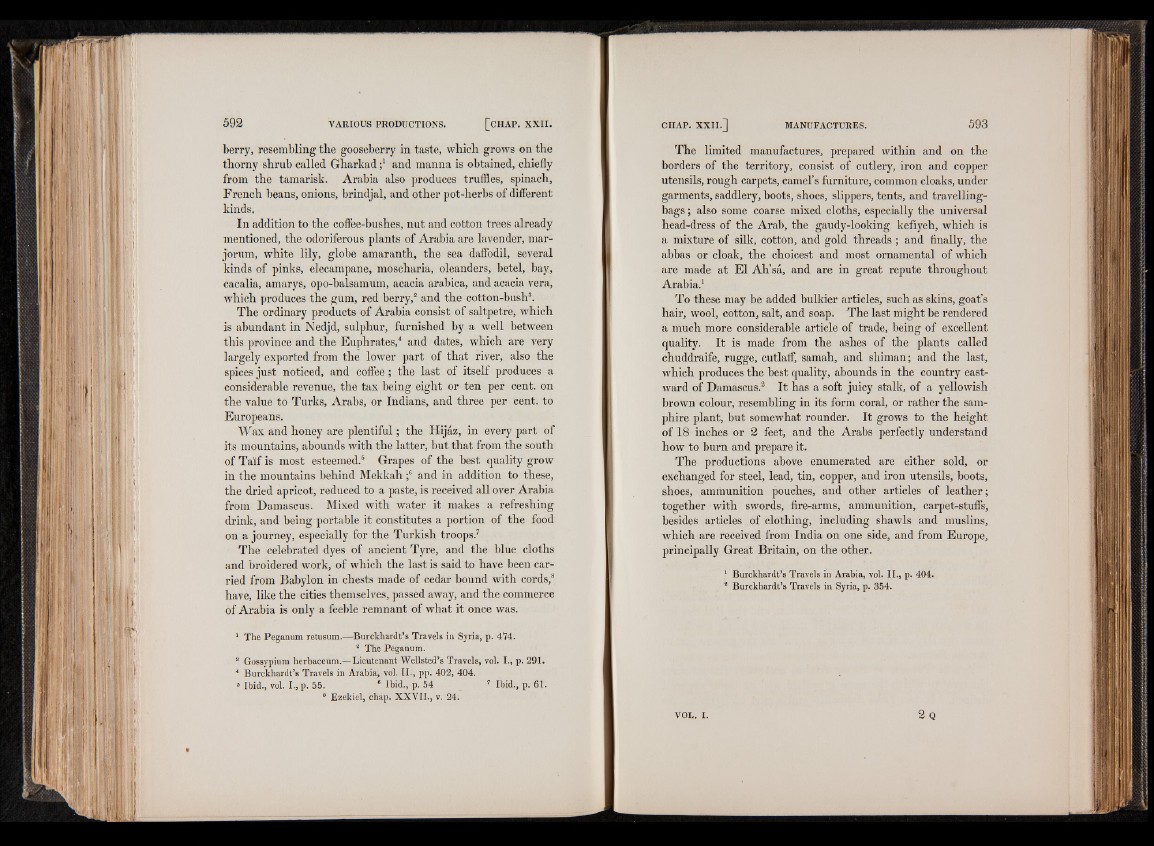
berry, resembling the gooseberry in taste, which grows on the
thorny shrub called Gharkad and manna is obtained, chiefly
from the tamarisk. Arabia also produces truffles, spinach,
French beans, onions, brindjal, and other pot-herbs of different
kinds.
In addition to the coffee-bushes, nut and cotton trees already
mentioned, the odoriferous plants of Arabia are lavender, mar-
jorum, white lily, globe amaranth, the sea daffodil, several
kinds of pinks, elecampane, moscharia, oleanders, betel, bay,
cacalia, amarys, opo-balsamum, acacia arabica, and acacia vera,
which produces the gum, red berry,8 and the cotton-bush3.
The ordinary products of Arabia consist of saltpetre, which
is abundant in Nedjd, sulphur, furnished by a well between
this province and the Euphrates,4 and dates, which are very
largely exported from the lower part of that river, also the
spices just noticed, and coffee; the last of itself produces a
considerable revenue, the tax being eight or ten per cent, on
the value to Turks, Arabs, or Indians, and three per cent, to
Europeans.
Wax and honey are plentiful; the Hijaz, in every part of
its mountains, abounds with the latter, but that from the south
of Ta'if is most esteemed.5 Grapes of the best quality grow
in the mountains behind Mekkah ;6 and in addition to these,
the dried apricot, reduced to a paste, is received all over Arabia
from Damascus. Mixed with water it makes a refreshing
drink, and being portable it constitutes a portion of the food
on a journey, especially for the Turkish troops.7
The celebrated dyes of ancient Tyre, and the blue cloths
and broidered work, of which the last is said to have been carried
from Babylon in chests made of cedar bound with cords,8
have, like the cities themselves, passed away, and the commerce
of Arabia is only a feeble remnant of what it once was.
1 The Peganum retusum.—Burckhardt’s Travels in Syria, p. 474.
1 The Peganum.
3 Gossypium herbaceum®-Lieutenant Wellsted’s Travels, vol. I., p. 291.
4 Burckhardt’s Travels in Arabia, vol. II., pp. 402, 404.
s Ibid., vol. I., p. 55. 6 Ibid., p. 54 7 Ibid., p. 61.
8 Ezekiel, chap. XXYII., v. 24.
The limited manufactures, prepared within and on the
borders of the territory, consist of cutlery, iron and copper
utensils, rough carpets, camel’s furniture, common cloaks, under
garments, saddlery, boots, shoes, slippers, tents, and travelling-
bags ; also some coarse mixed cloths, especially the universal
head-dress of the Arab, the gaudy-looking kefiyeh, which is
a mixture of silk, cotton, and gold threads ; and finally, the
abbas or cloak, the choicest and most ornamental of which
are made at El Ah’sa, and are in great repute throughout
Arabia.1
To these may be added bulkier articles, such as skins, goat’s
hair, wool, cotton, salt, and soap. The last might be rendered
a much more considerable article of trade, being of excellent
quality. It is made from the ashes of the plants called
chuddraife, rugge, cutlaif, samah, and shiman; and the last,
which produces the best quality, abounds in the country eastward
of Damascus.2 It has a soft juicy stalk, of a yellowish
brown colour, resembling in its form coral, or rather the samphire
plant, but somewhat rounder. It grows to the height
of 18 inches or 2 feet, and the Arabs perfectly understand
how to burn and prepare it.
The productions above enumerated are either sold, or
exchanged for steel, lead, tin, copper, and iron utensils, boots,
shoes, ammunition pouches, and other articles of leather;
together with swords, fire-arms, ammunition, carpet-stufls,
besides articles of clothing, including shawls and muslins,
which are received from India on one side, and from Europe,
principally Great Britain, on the other.
1 Burckhardt’s Travels in Arabia, vol. II., p. 404.
‘ Burckhardt’s Travels in Syria, p. 354.